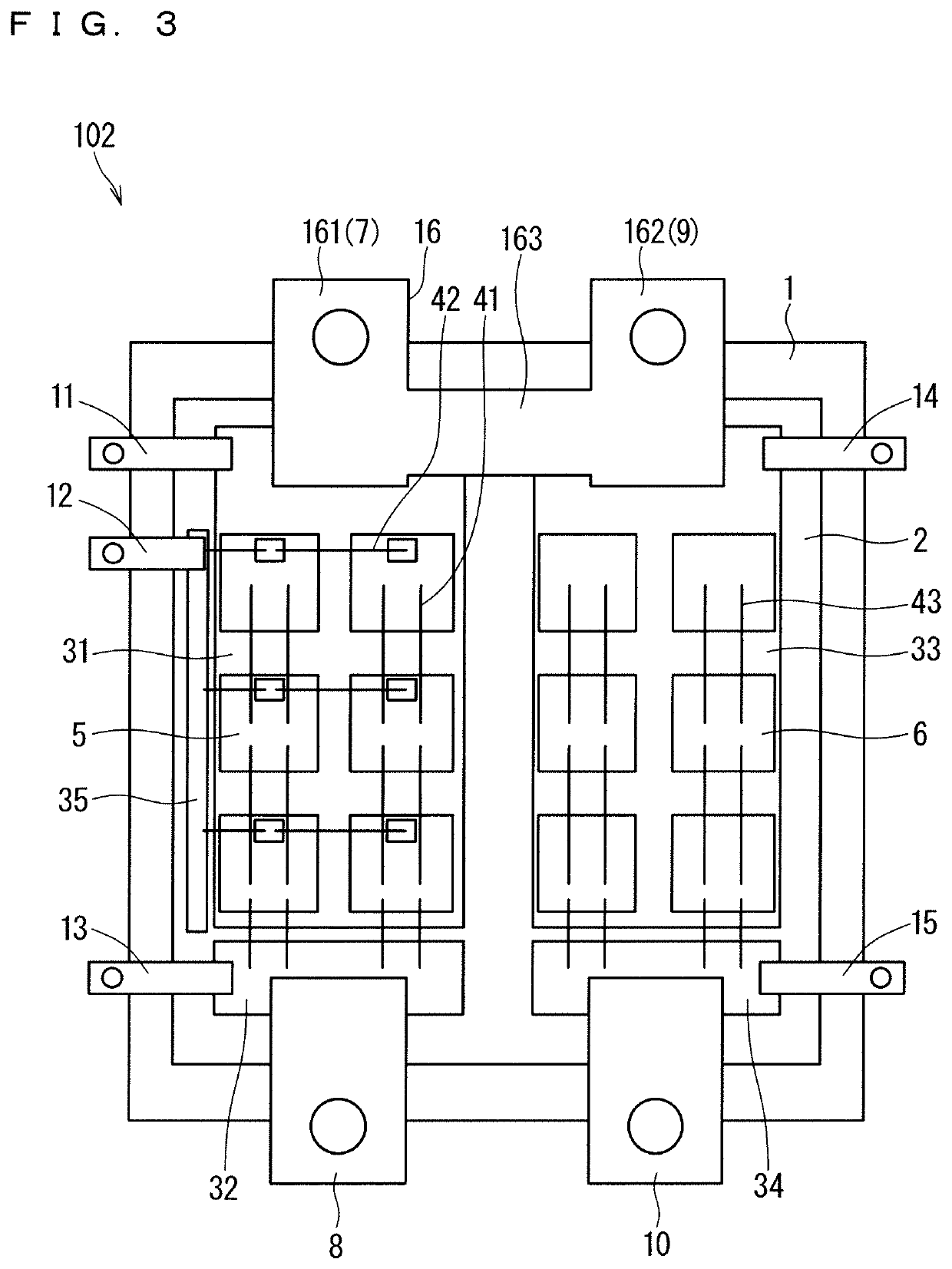Semiconductor device
a technology of semiconductor devices and semiconductor chips, applied in semiconductor devices, semiconductor/solid-state device details, electrical apparatus, etc., can solve the problems of difficult thermal design and affecting the thermal interference between the two types of chips, and achieve the effect of suppressing thermal interference between the mosfet chip and the sbd chip and facilitating thermal design
- Summary
- Abstract
- Description
- Claims
- Application Information
AI Technical Summary
Benefits of technology
Problems solved by technology
Method used
Image
Examples
embodiment 1
A. Embodiment 1
[0025]
[0026]FIG. 1 is a plan view of a semiconductor device 101 of Embodiment 1. The semiconductor device 101 includes a base plate 1, an insulating substrate 2, patterns 31, 32, 33, 34, and 35 being conductive patterns, a plurality of MOSFET chips 5, a plurality of SBD chips 6, a drain main terminal 7, a source main terminal 8, a cathode main terminal 9, an anode main terminal 10, a drain auxiliary terminal 11, a gate auxiliary terminal 12, a source auxiliary terminal 13, a cathode auxiliary terminal 14, and an anode auxiliary terminal 15.
[0027]The insulating substrate 2 is mounted on the base plate 1. The patterns 31, 32, 33, 34, and 35 are formed on the insulating substrate 2.
[0028]The plurality of MOSFET chips 5 are mounted on the pattern 31. Each MOSFET chip 5 has a drain electrode on the lower surface thereof and a source electrode and a gate electrode on the upper surface thereof. Therefore, by mounting each MOSFET chip 5 on the pattern 31, the drain electrode ...
embodiment 2
B. Embodiment 2
[0045]
[0046]FIG. 7 is a plan view of a semiconductor device 201 of Embodiment 2. In the semiconductor device 101 of Embodiment 1, the patterns 31 and 32 on which the plurality of MOSFET chips 5 are mounted and the patterns 33 and 34 on which the plurality of SBD chips 6 are mounted are provided on the same insulating substrate 2. Whereas, in the semiconductor device 201 of Embodiment 2, the patterns 31 and 32 on which the plurality of MOSFET chips 5 are mounted and the patterns 33 and 34 on which the plurality of SBD chips 6 are mounted are provided on different insulating substrates 21 and 22, respectively. That is, the insulating substrates 21 and 22 are mounted on the base plate 1 in the semiconductor device 201. And, the patterns 31 and 32 are formed on the insulating substrate 21, and the patterns 33 and 34 are formed on the insulating substrate 22. The configuration of semiconductor device 201 other than the above is the same as the semiconductor device 101.
[004...
embodiment 3
C. Embodiment 3
[0054]
[0055]FIG. 10 is a plan view of a semiconductor device 301 of Embodiment 3. In Modification 1 of Embodiment 1, the drain main terminal 7 and the cathode main terminal 9 are connected by being configured by the common terminal 16. Instead of this, in the semiconductor device 301, the pattern 31 being the drain conductive pattern and the pattern 33 being the cathode conductive pattern 33 are connected by conductive wires 44, so that the drain main terminal 7 and the cathode main terminal 9 are electrically connected. The configuration of semiconductor device 301 other than the above is the same as the semiconductor device 101 of Embodiment 1. An equivalent circuit diagram of the semiconductor device 301 is the same as the equivalent circuit diagram of the semiconductor device 102 illustrated in FIG. 4.
[0056]
[0057]In the semiconductor device 301 of Embodiment 3, the pattern 31 being the drain conductive pattern and the pattern 33 being the cathode conductive patter...
PUM
| Property | Measurement | Unit |
|---|---|---|
| conductive | aaaaa | aaaaa |
| current | aaaaa | aaaaa |
| wiring inductance | aaaaa | aaaaa |
Abstract
Description
Claims
Application Information
 Login to View More
Login to View More - R&D
- Intellectual Property
- Life Sciences
- Materials
- Tech Scout
- Unparalleled Data Quality
- Higher Quality Content
- 60% Fewer Hallucinations
Browse by: Latest US Patents, China's latest patents, Technical Efficacy Thesaurus, Application Domain, Technology Topic, Popular Technical Reports.
© 2025 PatSnap. All rights reserved.Legal|Privacy policy|Modern Slavery Act Transparency Statement|Sitemap|About US| Contact US: help@patsnap.com



